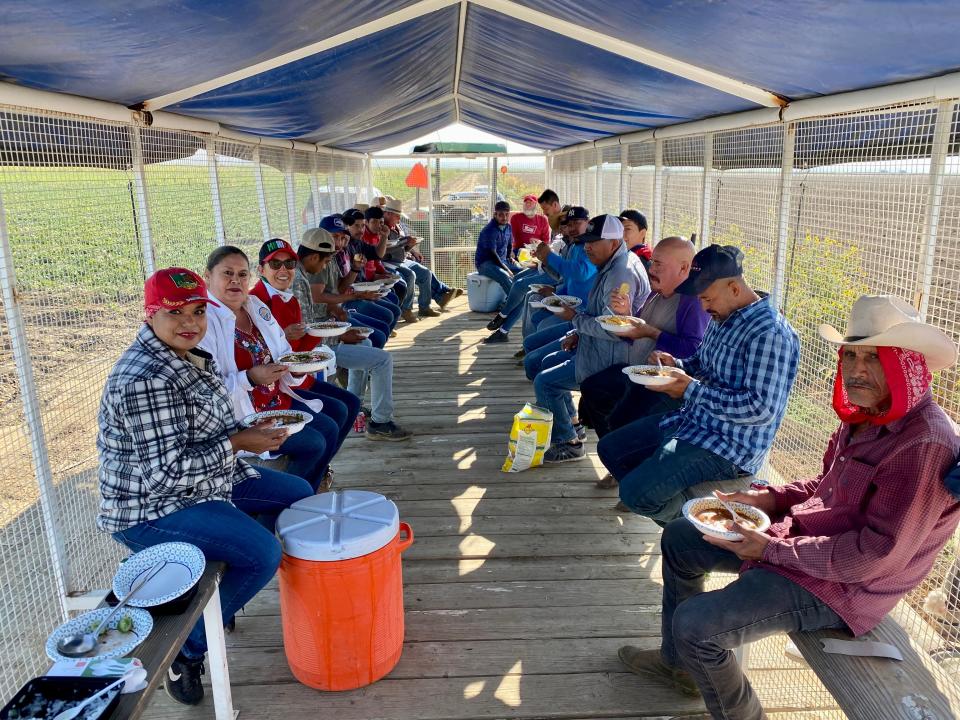John Augustine runs a 90-acre nursery outside Phoenix specializing in desert-adapted plants, trees and shrubs, and in the 50 years of running the business, he recalls only about six cases of heat illness.
At Augustine’s main operation, his Desert Tree Farm employs about 60 people. Crews have water coolers out in the field, “go at a nice pace” and take about three breaks.
He gives them this advice: Wear loose fitting, long-sleeved cotton shirts and a hat, start your work before daybreak, and avoid energy beverages. “Drink plenty water and drink more plenty water,” he says.
Like most people working outdoors in America’s hottest city, Augustine and his crew know how to cope in the summer months, just like people employed in construction, roofing, cooling systems and other service providers.
Agriculture is “hard, skilled work,” said Augustine. “And it is necessary work.”
There are about 1,527 farms in Maricopa County and about 30% of them hire farm labor, according to USDA census data. On about 260,000 acres of cropland, farms in the county produce cow milk, hay for cows that produce the milk, vegetables, melons, potatoes, other horticultural crops and nursery plants. Few farms hire more than 10 employees, both year-round and seasonal, and only 62 hire migrant workers.
To date there are no federal heat standards for outdoor or indoor workers, although the Occupational Safety and Health Administration published a proposed rule in July.
Longer shifts mean more breaks
Farmers who hire just a couple of full-time employees have longer shifts too. About 30 miles west of Phoenix in Waddell, Selwyn Justice ends his rounds at 3 or 4 a.m. and resumes at 8 a.m.
Harvest is still ongoing at the 30 acres of grapefruit orchards from the historic family farm, operating since 1928. This year is the latest they’ve ever harvested. The season goes from November to May, but because they sell locally, the Justice Brothers Ranch can still pick about 25% of the fruit that is not over-ripe to supply schools and distribute to Phoenix, Flagstaff and Tucson through the Sun Produce Co-op.
Justice starts the irrigation system at peak heat, around 4 p.m., and does rounds about every two hours to make sure it’s running properly. He ends that shift about 12 hours later, taking some time for sleep, and restarts to do picking and tractor work, hopefully in two of the three machines that have AC in the cabin.
“Discretion is the better part of harvesting this year,” which is why Justice, 35, does mostly all the picking himself this time of year. He has to be sensitive and choose fruit that is firm enough.
The farm has four full-time employees, and about two more in peak harvest season. One also works 12-hour shifts but there is an air conditioned office nearby for breaks. They take a one-hour lunch break and rest as much as possible. If they’re not in the orchard, which provides shade, they set up a huge umbrella at the end of the field and use water stations. If it’s above 113 degrees they call it quits.
“There’s nothing that we do that is worth the health risk of being out in that kind of temperature,” Justice said.
A judgment call
Some farmwork is necessarily more intensive.
“One thing about melons is that once it’s ready, it’s ready. You can’t wait,” said Augustine, a lifelong farmer, about the harvest season. He did some picking work in the late 1960s in Yuma, getting up at 3 a.m. to harvest before light. “It’s hard work.”
Canteloupes and honeydew peak harvest season matches the peak of summer. Seasonal workers usually start picking the fruit around July and finish by September, with temperatures often above three digits in Arizona, but there is fieldwork and preparation needed as early as April.
The season requires many workers and because it requires more physical labor, there is higher risk of heat-exhaustion.

Del Bosque Farms’ crews, in Fresno County, California, harvest from 6 a.m. to 2:30 p.m. A field person refills their jugs with water and ice along the day. During their break, workers jump to a retrofitted cotton trailer, a 30-foot long wagon with metal mesh, that has benches inside and a canopy for shade.
Sometimes, when scorching temperatures are sure to put someone at risk of heat illness, they cut the day short. It’s undesirable for everyone: Workers don’t get a full day’s pay and the farm is likely to lose fruit in the fields. It’s also not mandated by California heat standards, which have been in place since 2005.
“It’s a judgment call,” said farm owner Joe Del Bosque. When it’s hot, more fruit ripens and there is more to pick. If workers go home early, that fruit stays in the field and gets scorched.
“When you lose crop you lose a lot of money. It’s happened to me before,” he said. But in most cases, he will choose to send people home for safety. He and his wife Maria Gloria were farmworkers, and are still in the field every day. “We don’t want anybody to get sick. We need everybody on the job.”
Most of the workers are recurring, but they still go through safety training every season, and every Monday, they have short refreshers on heat illness, food safety, machinery operation or other topics. Del Bosque also goes through many hours of training and certification and is chair emeritus of a nonprofit dedicated to farmworker safety.
Even with no federal or state standard, it is farmers’ responsibility to take care of their workers and provide safe working conditions, Del Bosque said.
Clara Migoya covers agriculture and water issues for The Arizona Republic, part of the USA TODAY Network, and can be reached at [email protected].
One week in the Phoenix heat: Living and dying in America’s hottest big city
When heat hurts: ER doctors treat heatstroke, contact burns on Phoenix’s hottest days
‘Hotter than it’s ever been’: How this 93-year-old copes with Phoenix’s 100-degree heat
Measuring heat: How to do it correctly, according to scientists, and why it matters
Dying in America’s hottest city: Meth and heat are a deadly mix. Users in Phoenix rarely get the message
‘Reverse winter’: When summer is in full swing, Phoenix-area AC repair crews can be life savers
Working outside Without legal protections, farmworkers rely on employers to survive extreme heat
Keeping cool at the zoo: Extreme heat takes a toll on animals and plants. What their keepers do to protect them
This article originally appeared on Arizona Republic: Without legal protections, farmworkers rely on employers in the heat















